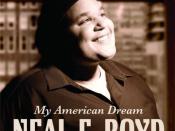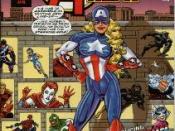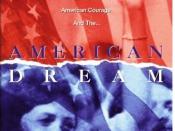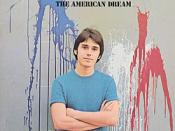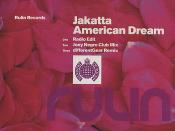The ÃÂAmerican Dreamàis the belief that through hard work, courage and determination, an individual can achieve prosperity and wealth. In pursuit of this ÃÂdreamÃÂ, individuals become unsatisfied, and discard values and morals in exchange for a materialistic façade.
Through the reading of FitzgeraldÃÂs novel, ÃÂThe Great GatsbyÃÂ and the viewing of MendesÃÂ ÃÂAmerican BeautyÃÂ, an interpretation of this situation becomes apparent. Though set in different time periods, with one being a film and one being a novel, they present the same ideas of the failure of the shallowness of the ÃÂAmerican DreamÃÂ, and the materialism and consumerism society that evolved from the pursuit of it. Each composer does this through the use of various techniques and values held by main characters in each story, and how they are influenced by their historical context.
ÃÂThe Great GatsbyÃÂ was set in the 1920ÃÂs.
In this time period, often referred to as the ÃÂRoaring Twenties, was a disillusioned and broken society, tarnished by the effects of World War One. The novel represents the importance placed on wealth and social status in American society at the time. A vulnerable society, they placed higher priority on material satisfaction than personal satisfaction to compensate. They soon became reliant on this ÃÂmaterial wealthÃÂ, and the obsession was usually funded by illegal or immoral methods.
MendesÃÂ ÃÂAmerican BeautyÃÂ, was set in the 1990ÃÂs. It too is a product of the values and attitudes present in the historical context in which it was set. Mendes perfectly satirizes the contemporary American ideals of the perfect family, house and job of the 1990ÃÂs. Similar to the 1920s, the choice of occupation of individuals in American society was purely based on its material benefits, not the personal fulfillment one would gain.
Fitzgerald symbolizes this in his novel, through the character Jay Gatsby. Gatsby, whose life-long pursuit of DaisyÃÂs love had failed once before, vows to regain her love. His acquisition of material wealth is an attempt at doing this, believing he can ÃÂbuyÃÂ DaisyÃÂs affection with it. GatsbyÃÂs pursuit of his ÃÂdreamÃÂ is ultimately unsatisfying of the spiritual happiness he requires.
To further emphasise the materialism of GatsbyÃÂs dream, Fitzgerald uses GatsbyÃÂs extravagant parties as a symbol of his material wealth, and another way for Gatsby to each Daisy, ÃÂin a way, his ostentatious house and expensive parties are an elaborate advertising display designed to impress DaisyÃÂ. This quote from Nick, expresses how GatsbyÃÂs pursuit of the American Dream has failed, as he has ultimately gained nothing. It shows how the desire to achieve the American Dream influenced American Society to disregard personal satisfaction in order to achieve prosperity and material wealth.
Mendes charaterises this idea in the film, through the attitudes and values Carolyn. In the film, she adheres to what was seen as a typical American, associated with the perfect family, lifestyle, job etc. The opening sequences in which we see her house, surrounded by picket fences and bright red roses, portrays that same ÃÂperfectionÃÂ about the familyÃÂs lifestyle.
The quote ÃÂher gardening .. matches her shoesÃÂ shows how her pursuit of the American Dream has influenced her to forego her personal fulfillment, in order to achieve the ÃÂperfectionÃÂ associated with the American Dream.
Through the use of dialogue, Mendes communicates the disillusioning effect the American Dream has on an individual, and how the pursuit of it often leads to the disintegration of the individualÃÂs spiritual happiness. Mendes shows this when Carolyn says, ÃÂIn order to be successful I need to project an image of success at all timesÃÂ. A shot of Carolyn crying straight after emphasises MendesÃÂ point.
Another point MendesÃÂ makes, is how the pursuit of the perfect life (American Dream) can affect the lifestyles of families in general. The BurnhamÃÂs were once a happy, functional family. CarolynÃÂs pursuit of material wealth has depleted her relations with her family members, especially her husband Lester. The contrasting sides of Carolyn are explained by Lester, who, when about to get intimate with Carolyn says, ÃÂa girl who used to fake seizures at frat parties when she got bored. And who used to run up to the roof of our first apartment building to flash the traffic helicopters.ÃÂ As they get closer, Carolyn ruins the mood completely by saying, ÃÂThis is a four thousand dollar sofa upholstered in Italian silk. This is not ÃÂjust a couchÃÂ.ÃÂ This shows how CarolynÃÂs pursuit of the American Dream, and the subsequent priority she has given to material wealth over more important things.
Throughout both texts, the use of facades helps the composers convey the importance material wealth has in society, regardless of the historical context it is in. In each, the facades represent the desire to appear ÃÂperfectÃÂ. These facades are evident in each of the main families portrayed in each text.
For example, in ÃÂThe Great GatsbyÃÂ, the BuchananÃÂs create a façade of happiness. Furthermore, Tom Buchanan creates a façade of ÃÂperfectionÃÂ, both physically and intellectually, and strives to uphold this image.
In ÃÂAmerican BeautyÃÂ, the BurnhamÃÂs are a family disintegrating behind the façade of ÃÂperfectionàthey have created for themselves. Carolyn aims to come across as confident, successful and happy. Jane creates the façade of a young rebellious teenager, who strives to achieve what any other normal teenager aims for; popularity. However, as the story progresses, the facades created by both of these characters evaporates, and their true selves are revealed. Carolyn is not who she seems to be, but really, a helpless, lackluster woman who places more value on her image than her own fulfillment. Jane ditches the façade of a ÃÂnormalàteenager, and eventually embraces confidence in herself, and her image. These façadeÃÂs created, are seen as results of individuals pursuits of the American Dream, and their desire to be ÃÂperfectÃÂ.
In both stories however, there is a common idea. One person, who strives to rebel against the ideals of the society in which they live. They object to the pursuit of the American Dream, and choose to hand priority to personal satisfaction, rather than material wealth and satisfaction.
In ÃÂThe Great GatsbyÃÂ, this person is Nick. Nick, throughout the story, curses the corruption experienced in the East Egg. He realizes that he does not belong there, as he came from the part of society that represented purity, ÃÂand perhaps we possessed some deficiency in common which made us subtly unadaptable to Eastern life.ÃÂIn ÃÂAmerican BeautyÃÂ, Lester, the narrator of the story, realizes early on, that he did not want be another pawn in society chasing the American Dream. He vowed early on, to change his lifestyle, and rebel against those who had conformed, i.e his wife Carolyn.
In conclusion, the two texts ÃÂAmerican BeautyÃÂ and ÃÂThe Great GatsbyÃÂ, however different the time periods were, clearly portrayed the way the American Dream influenced individuals. It influenced them to change their values, attitudes and morals, in their pursuit of ÃÂperfectionÃÂ, and ultimately led them to prioritise material wealth and satisfaction, over that of themselves, and the people close to them.
Films - American Beauty and The Great Gatsby
